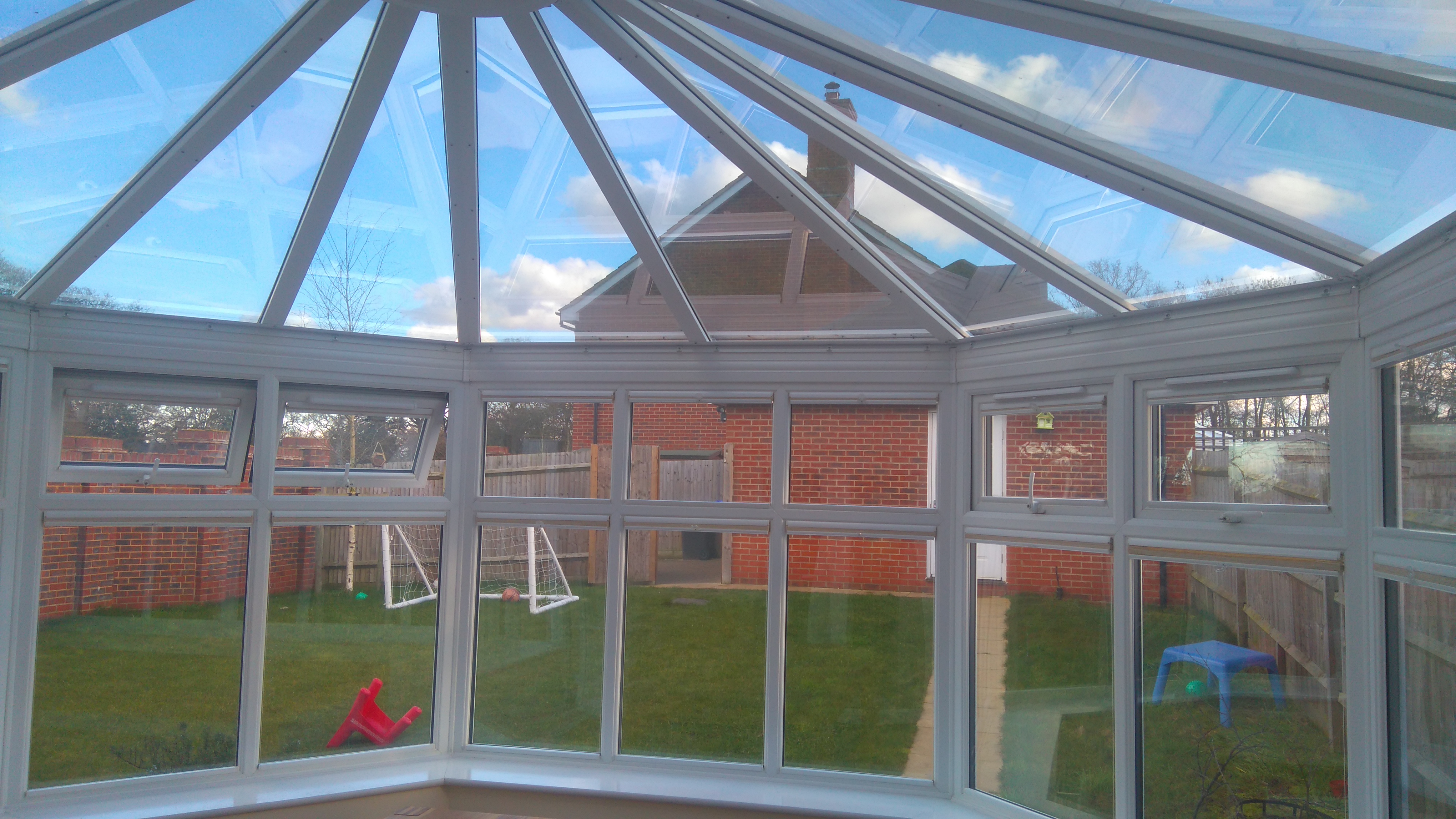10 Considerations When Choosing Conservatory Roof Films & Conservatory Window Films
1. My conservatory is like an oven. Which type of conservatory roof film and conservatory window film should I choose?
The degree of discomfort is a valuable pointer to which shading system to choose. The external face of the conservatory roof window film must be very reflective if fitted internally. Whatever you do, it is important that you do not invest in a non-reflective conservatory roof window film to be fitted internally to your conservatory or orangery roof glazing.
If the sun’s radiant heat is really intense then consider spectrally selective conservatory reflective films. What are spectrally selective window films and why are they important? Spectrally selective films take out more of the sun's uncomfortable radiant heat, the part that makes you feel hot, even on a cold day. They embrace more of the natural light. Natural light will lead to a gradual increase in the air temperature (after all, it is half the sun's energy that reaches the earth) but in our considerable experience can be handled by opening a window or door.
The New Scientist article explains the concept of radiant temperature vs air temperature. https://www.newscientist.com/lastword/mg23531361-100-feel-the-heat/
3M All Seasons 35 is a good example of a spectrally selective, reflective film for the glass roof and 3M Prestige 70 External is a good example of a non-reflective, externally-fitted external film for the side glazing. Most clients prefer the side glazing windows not to be reflective as it will be like looking into a mirror if you use the conservatory or orangery at night.
The time not to use a spectrally selective window film is when glare is a major issue. Glare needs to be tackled with a much darker film in order to reduce the amount of light entering the space.
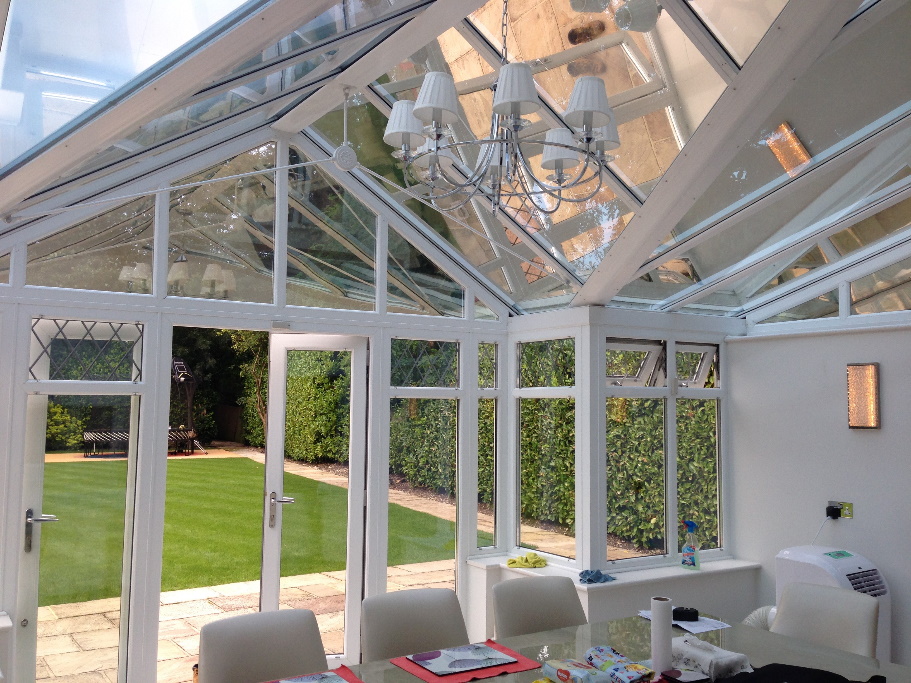
Book your free callback now!
2. Should I choose an internal or external application of conservatory window film?
We used to install conservatory roof window films externally in order to improve performance whilst preserving light levels. However, that was before we could offer the amazing 3M All Seasons 35, which is an internal conservatory roof window film that reflects more of the sun's radiant heat than other internal conservatory films whilst letting in almost twice as much natural light as similar films compared with most films offered in the UK.
Our finding is that a very high-performing internal conservatory roof film solves the heat issue for the vast majority of people without the need to install it externally.
Part of the problem with installing external conservatory roof window film is that:
1. The life expectancy of the conservatory film is considerably reduced;
2. The cost is greater; and
3. There is a small risk of damage to the roof glazing. This could result in leaks occuring.
However, we do recommend an external application of non-metallized conservatory window films to the side glazing. An example is the spectrally-selective 3M Prestige 70 External, which is constructed with about 240 microscopic layers of high-quality, optically clear polyester, each one reflecting part of the sun's solar spectrum. The performance is outstanding because it is not having to reject the heat through an efficient double glazing system. The life expectancy is very good because there are no metals that can corrode over time.
A budget conservatory window film option for the side glazing is Solargard Silver 50 External.
![]()
3. The appearance of conservatory window film samples.
Today, as I am writing this, the light level outside is 68,000 lux at midday on the 4th of May. Lux is a measure of light. The higher the number the brighter it is. The level in my heavily filmed conservatory is 7500 lux. The level inside the house is 100 to 150 lux in the middle of the living room. The guidance for an office environment is 300 to 750 lux.
The temperature in the sun is 29 degrees Celsius and the temperature in the shade is 19 degrees Celsius. My conservatory is comfortable thanks to conservatory shading film.
Looking at a conservatory window film sample in a bright environment will make the sample appear darker. Samples tend not to be helpful and result in clients going for a conservatory window film that is too light.
If you are worried that the conservatory roof film will be too dark then rest assured that the reduction of light you see is significantly higher than the measured light reduction. Your eye and brain combine to be like a camera lens. The pupil adjusts and is smaller when the environment is bright.
Visible Light Transmission With Film
Light Transmission Perceived By The Human Eye
100%
100%
80%
80%
60%
82%
33%
68%
18%
55%
Table sourced from Solargard
Ask for samples that are mounted on card and then look through the film and not round the film towards the light source. Try and avoid looking at the contrast with the glazing as this will not be present when the film is installed.
Important – look at the sample in different light conditions. If you use the conservatory at night then examine the window film sample at night. In our considerable experience, reducing light levels through a conservatory roof tends never to be an issue as an abundant amount of glass transmits about three times more than the side glazing.
4. The glass type should influence the choice of conservatory window film.
Is the roof made of polycarbonate or glass? Is the glazing a modern solar glazing or older double glazing without solar control?
Some films lend themselves to certain types of glazing.
It is important to engage with a company, like WindowTreat, that can tell you how each film performs on YOUR glazing. These companies are few and far between.
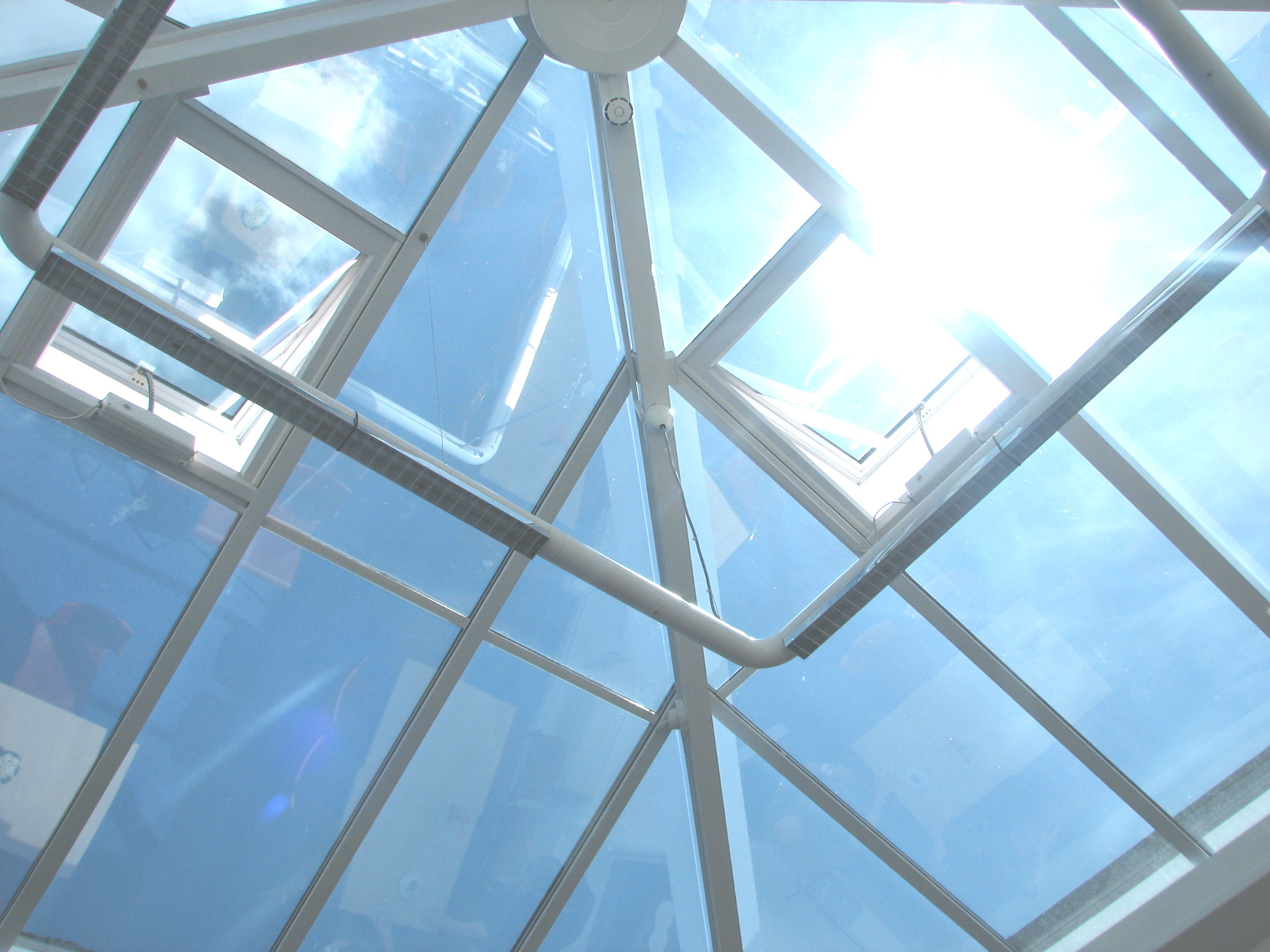
Book your free callback now!
5. How do you use the conservatory?
Think about how you will use the conservatory. If you plan to watch television or use a laptop then you will want to reduce glare. Glare is directly related to the amount of sunlight transmitted into the space. In which case, choose a significantly darker film such as low to reflect extreme and consider filming the side glazing with a medium tint film such as 3M Prestige 40 instead of 3M Prestige 70 external.
If you love the natural light in abundance then a lighter conservatory roof film such as 3M All Seasons 35. It will transmit virtually twice as much natural daylight and still outperform other conservatory roof window films because it reflects more solar energy.
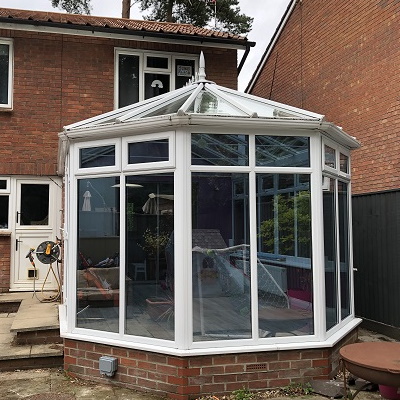
6. What about conservatory window film for the side glazing?
Most solar heat gain is typically through the roof and therefore shading the roof is the highest priority. Filming the side glazing typically increases the usable space within the conservatory so that you can sit next to the glazing in comfort.
Fading of furnishings will be significantly reduced by filming the side glazing.
3M Prestige 70 external is virtually undetectable so you don't need to film every window. You can cherry-pick the conservatory windows that suffer most from the heat.
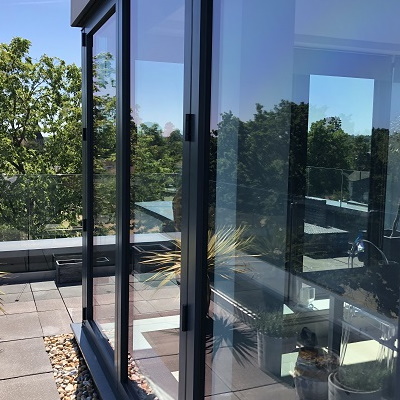
7. What if I am on a very tight budget?
If budgets are tight and your primary objective is to spend as little as possible then look no further than a Silver 20. These feature an older technology that still does a good job. The colour rendition is a little colder and the film is dark. However, if you suffer from a lot of glare then that is not such a bad thing.
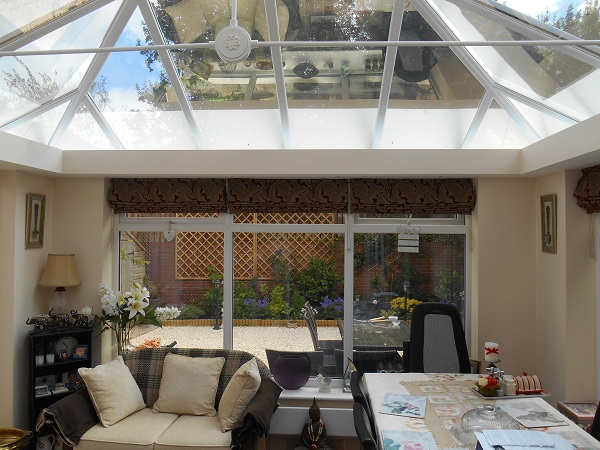
8. Are you trying to protect furnishing and surfaces from fading?
Conservatory window films all do a good job at reducing the rate of fading. Filming the roof glazing will help. However, if the furnishings are adjacent to windows then it is advisable to invest in window film for the side windows. Then combination of filming the roof and side glazing will keep your furnishings looking newer for 3 times longer.
![]()
9. Does the conservatory get chilly?
The conservatory is a glass room so it is not surprising that it is not usable during colder weather without heating the space.
How much is it worth to you to enjoy your conservatory for more hours each day and for more weeks and months each year?
Our advice is to consider filming the roof glazing with a product like 3M All Seasons 35 which reduces heat loss by about 10 percent on modern glazing and to film the side glazing with Solargard Ecolux on the side glazing.
The clever bit is to invest in radiant heating (Surya Heating) and a Low-E window film such as Solargard Ecolux on the roof and 3M Thinsulate Climate Control 75 on the side glazing,
Radiators heat air and the conservatory is a very big space which means that there is a lot of air to heat. Radiant heaters provide instant heat to surfaces. It is a bit like sitting in front of a fire or log burner, Solargard Ecolux relfects 90% of the radiant heat back into the room resulting in much greater comfort and fewer cold spots. The energy savings of this approach are significant.
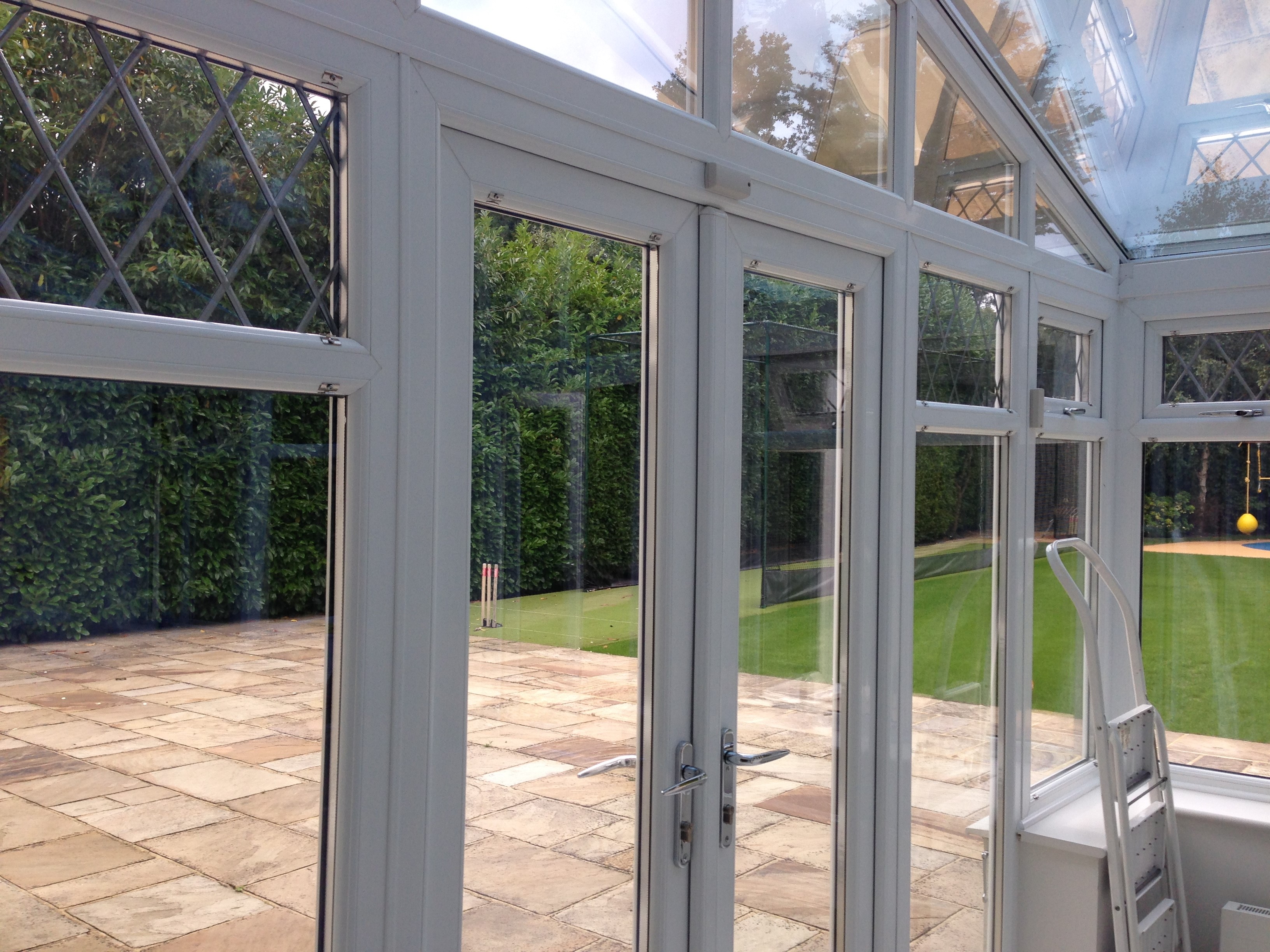
10. Evaluating the performance of different conservatory cooling and shading window films is a minefield.
This highly misleading quote is taken from the UK's most visited window film website, "Known as supertint glass, our conservatory cooling film works by rejecting up to 78% of the sun’s total solar energy".
The impressive, but very misleading figure is actually for the combined performance of a very basic conservatory window film applied to single pane glass, the equivalent of thin greenhouse glass.
Firstly, it is highly unlikely that you have single glazing. Secondly, you would probably like to know the actual improvement that the conservatory window film will make on your conservatory roof.
The reality is that the above film is likely to reduce the solar heat gain by between 30 percent and 44 percent on a modern conservatory glass roof. It is not a bad result, but a million miles away from the 78 percent mentioned.
We use software from the Lawrence Berkeley National Laboratory to calculate how much solar energy is transmitted with and without conservatory window film on glazing just like yours.
This article is a useful guide, albeit a bit on the techy side. Click Review of Conservatory Window Films.
